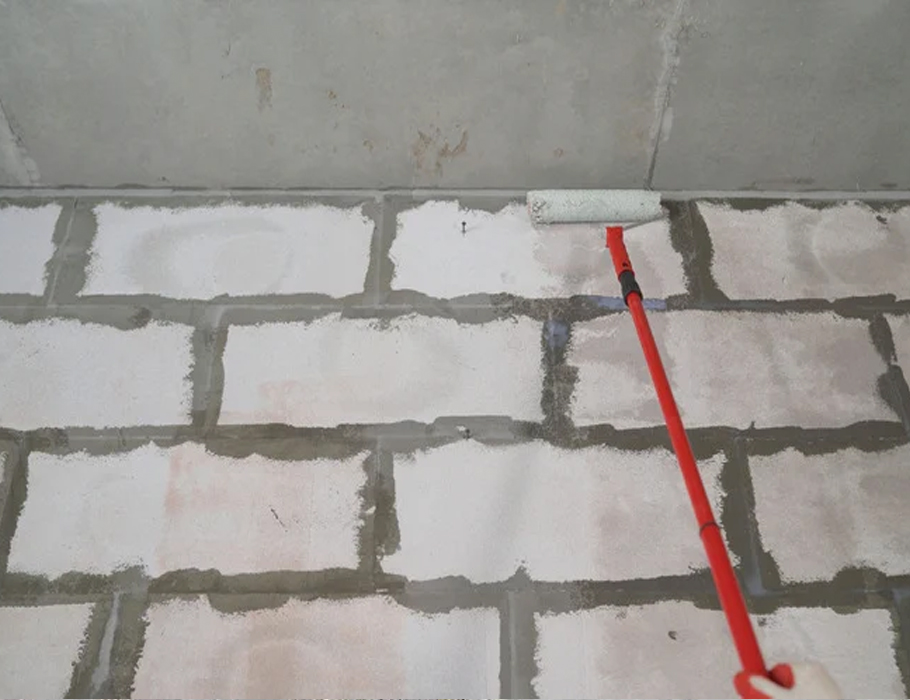Waterproofing Guide
Internal walls may not face direct rain, but they often suffer from hidden moisture, leakages, and rising dampness. Left untreated, this can cause ugly stains, peeling paint, bad odors, and even weaken the structure. Here's a simple guide to keep your interiors safe and beautiful:
1. Identify Moisture Sources
Look for signs like damp patches, bubbles in paint, efflorescence (white powdery deposits), or a musty smell. Also, check if moisture is coming from leaking pipes, bathrooms, kitchens, or rising from the floor.
2. Surface Preparation
Remove damaged paint, plaster, and clean the surface thoroughly. A dry and dust-free wall ensures the waterproofing system bonds effectively.
3. Treat Cracks and Joints
Seal all visible cracks with a high-quality crack filler. Pay special attention to corners, window frames, and wall joints, which are common leakage points.
4. Choose the Right Waterproofing System
For internal walls, use breathable and water-resistant systems such as:
• Cementitious waterproof coatings
• Interior-grade moisture barrier primers
• Waterproof putties and sealants
These prevent moisture migration without trapping it inside the wall.
5. Application
Apply the waterproofing layer evenly over affected walls, followed by a high-quality putty or skim coat for a smooth finish. Finally, use moisture-resistant paints for longer protection.
6. Fix the Root Cause
If the dampness is due to plumbing leaks or external seepage, address these issues first to ensure your internal waterproofing is effective.
7. Routine Checks
Inspect walls, especially after monsoon or plumbing work. Early maintenance saves costly repairs later.
✅ Pro Tip:
Protect your interiors with ADT Internal Wall Waterproofing Solutions — because beautiful walls start with dry, healthy surfaces!

Categories
INTERNAL WALL WATERPROOFING:
1. What is Internal Wall Waterproofing?
Internal wall waterproofing is a protective process that prevents moisture penetration, dampness, and water damage inside buildings. ADT Industries Pvt Ltd provides advanced waterproofing solutions to protect walls from water seepage and humidity-related issues.
2. Why is Internal Wall Waterproofing Important?
Water seepage in internal walls can cause:
- Peeling paint and plaster damage
- Damp patches and mold growth
- Weakening of structural integrity
- Unpleasant odors and unhealthy living conditions
Proper waterproofing ensures long-term protection and maintains the beauty and strength of your walls.
3. What waterproofing solutions does ADT Industries Pvt Ltd offer for internal walls?
ADT Industries provides:
- Cementitious waterproofing (for walls and ceilings)
- Liquid waterproofing membrane (for seamless protection)
- PU and epoxy coatings (for high durability and flexibility)
- Crack filling and injection grouting (for sealing leaks)
- Anti-damp paints and coatings (for long-term moisture resistance)
4. What are the common causes of internal wall dampness?
- Leaking pipes inside walls
- Water seepage from adjacent bathrooms or kitchens
- High humidity and condensation
- Rainwater penetration through external walls
5. How is the internal wall waterproofing process done?
- Inspection & Diagnosis – Identifying moisture sources and damage.
- Surface Preparation – Cleaning and removing damaged plaster.
- Application of Waterproofing – Coatings, sealants, or membranes are applied.
- Finishing & Painting – Walls are repainted or re-plastered for a smooth finish
6. Can waterproofing be done on already damp walls?
Yes! ADT Industries first dries and treats the dampness, repairs the surface, and then applies waterproofing solutions to prevent future seepage.
7. What are the signs that my internal walls need waterproofing?
- Damp patches or water stains on walls
- Peeling paint or bubbling wallpaper
- Mold or mildew growth
- Cracks appearing due to moisture damage
8. How long does internal wall waterproofing last?
With high-quality materials and expert application, waterproofing can last 8–10 years with proper maintenance.
9. Is the waterproofing process safe for health and the environment?
Yes! ADT Industries uses eco-friendly, non-toxic waterproofing solutions that are safe for residential and commercial spaces.
10. How much time does the waterproofing process take?
Depending on the extent of damage and area size, the process typically takes 2–5 days.
11. How much does internal wall waterproofing cost?
The cost depends on:
- Wall area to be treated
- Type of waterproofing used
- Extent of damage and repairs required Contact ADT Industries for a free inspection and customized quote.
13. How do I schedule a roof waterproofing service?
You can contact ADT Industries Pvt. Ltd. via phone, email, or our website to book an inspection and get expert consultation on the best waterproofing solutions for your roof.
Real-Life Examples of Internal Wall Waterproofing by ADT Industries
Case Study 1: Residential Wall Dampness – Mumbai
Solution: ADT Industries applied injection grouting to seal leakage points and used a cementitious waterproofing layer on the affected walls.
Result:The dampness was eliminated, and the walls remained dry even after months of use.
Case Study 2: Office Wall Seepage – Bengaluru
Solution: ADT Industries applied a PU waterproofing coating and an anti-damp wall treatment.
Result: The problem was resolved, and the office maintained a professional, odor-free environment.
Case Study 3: Apartment Living Room Seepage – Delhi
Solution: ADT Industries used crack filling techniques, sealed the tiles in the neighbor’s kitchen, and applied an epoxy waterproofing layer on the affected wall.
Result: The seepage was completely stopped, and the living room walls remained damage-free.